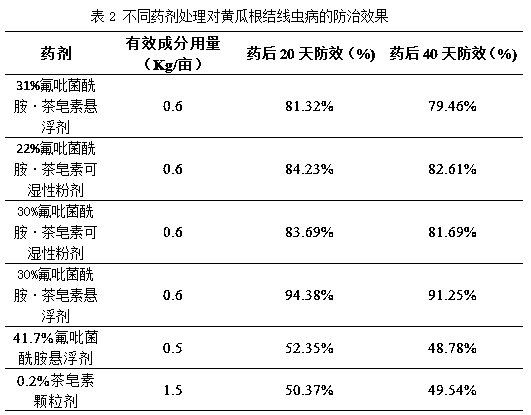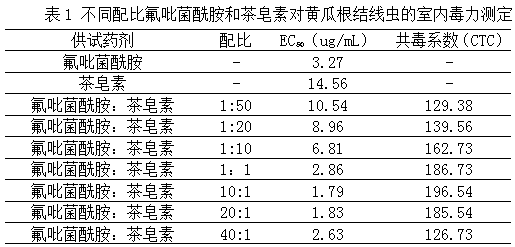A nematocidal composition containing fluopyram and tea saponin
A fluopyram and tea saponin technology, which is applied in the directions of nematicides, biocides, biocides, etc., can solve the problem that there is no combination of fluopyram and tea saponin, so as to save drug costs, The effect of reducing usage and easy process control
- Summary
- Abstract
- Description
- Claims
- Application Information
AI Technical Summary
Problems solved by technology
Method used
Image
Examples
preparation Embodiment
[0017] 1. Example 1: 31% fluopyram·tea saponin suspension concentrate (30:1)
[0018] Fluopyram 30%
[0019] Tea Saponin 1%
[0020] Fatty alcohol polyoxyethylene ether 5%
[0021] NNO 3%
[0022] Magnesium Aluminum Silicate 1.4%
[0023] Xanthan Gum 0.2%
[0024] Ethylene glycol 1%
[0025] Deionized water balance
Embodiment 2
[0026] 2. Example 2: 22% fluopyram·tea saponin wettable powder (10:1)
[0027] Fluopyram 20%
[0028] Tea Saponin 2%
[0029] Calcium dodecylbenzenesulfonate 2%
[0030] Sodium lignosulfonate 3%
[0031] Silica 7%
[0032] Diatomaceous earth balance
Embodiment 3
[0033] 3. Example 3: 30% fluopyram·tea saponin wettable powder (1:1)
[0034] Fluopyram 15%
[0035] Tea Saponin 15%
[0036] Calcium dodecylbenzenesulfonate 3%
[0037] Sodium lignosulfonate 4%
[0038] Silica 7%
[0039] Diatomaceous earth balance
[0040] 4. Example 4: 30% fluopyram·tea saponin suspension concentrate (17:13)
[0041] Fluopyram 17%
[0042] Tea Saponin 13%
[0043] Fatty alcohol polyoxyethylene ether 5%
[0044] NNO 3%
[0045] Magnesium Aluminum Silicate 1.4%
[0046] Xanthan Gum 0.2%
[0047] Ethylene glycol 1%
[0048] Deionized water balance
[0049] 2. Indoor toxicity test
[0050] Test name: Indoor toxicity determination of fluopyram and tea saponin against cucumber root-knot nematode
PUM
 Login to View More
Login to View More Abstract
Description
Claims
Application Information
 Login to View More
Login to View More - R&D Engineer
- R&D Manager
- IP Professional
- Industry Leading Data Capabilities
- Powerful AI technology
- Patent DNA Extraction
Browse by: Latest US Patents, China's latest patents, Technical Efficacy Thesaurus, Application Domain, Technology Topic, Popular Technical Reports.
© 2024 PatSnap. All rights reserved.Legal|Privacy policy|Modern Slavery Act Transparency Statement|Sitemap|About US| Contact US: help@patsnap.com









